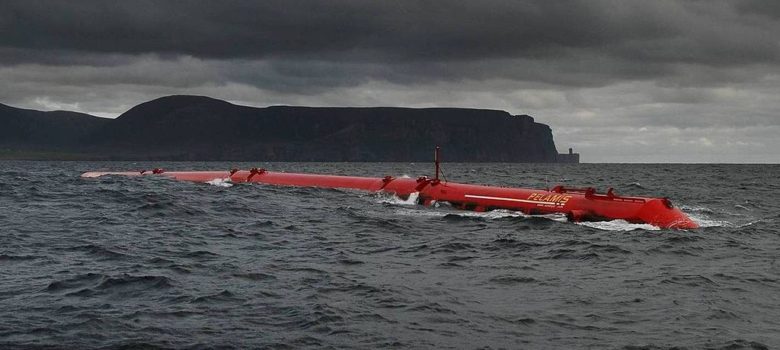
What is wave energy?
There are many different designs out there that harness the energy from our oceans’ waves. Wave energy uses the movement of waves to generate electricity. The technology is continually being modified so that it may one day be able to contribute a large proportion of the energy needed to power coastal countries. If the UK were to harness this technology it could supply a lot of power to the coastal towns and villages. Australia, for example, could supply over 60% of its own energy from wave energy alone. It certainly also helps when countries also have over 300 days of sunshine and can harness solar power as well.
How does wave energy work?
Below are three examples of wave energy, technological solutions:
Oscillating water column (OWC)
For OWC technology, it is not the waves that move the turbines directly, but a mass of compressed air that is pushed by these waves. This involves a structure usually located in a breakwater, the upper part of which houses an air chamber (thus the compressed mass of air) and its lower part is being submerged under the water. In this way, the turbine takes advantage of the movement caused by waves, both when they come in and when they go out, and the doubly-fed generator (both by its rotor or mobile part and by the stator or fixed part) to which it is coupled then feeds energy to the grid.
Floatation platforms
The platforms draw energy from wave power by floating with the rising and falling motion of waves. The floats are attached by arms to a platform that stands on legs secured to the sea floor. The motion of the floats is transferred via hydraulics into the rotation of a generator, producing electricity.
Channelling the wave
A third approach is to use channels near the shore to store the energy in an elevated reservoir. Then as the water flows back out of the reservoir a standard hydroelectric water turbine is used to generate electricity.
Seafloor carpets
Harnessing the power of waves from the seafloor has often been touted as the best possible way. This is because of the lack of disruption to fishing, leisure and shipping that is often caused by surface-based technologies. These seafloor carpets use the turbulence created by the waves above to power pistons and create hydraulic pressure, which can be turned into electricity to power homes, or used for desalination.
UK wave energy development
In the UK, wave energy is classified as part of marine energy, along with tidal energy. This is why in policy terms sometimes these two areas are referred to interchangeably. In January 2012, there was an announcement of the creation of the first Marine Energy Park (MEP) in the south-west of the UK. This will allow the collaboration between the private and public sector to embark on wave and tidal projects from Bristol to Cornwall and the Isles of Scilly.
Wave energy like tidal power is supported by tradeable ROCs. The current level of support is 2 ROCs per MWh of electricity generated. After the 2011, the level of support is to increase to 5 ROCs per MWh. The idea is that for the next few years the UK government needs to support emerging technologies so that they can become the cutting edge solutions of the future. As the technology in this is still developing, the output cost of electricity produced is greater than for fossil fuels. It is for this reason that both UK and Scottish Governments have a large role to play. The Green Investment Bank, when it goes live, is more likely to lend to projects that are close to mass scale expansion rather than funding any research and development stages.
Berkeley, California, and the seafloor carpet
A team including, Reza Alam and Marcus Lehmann, have come up with a revolutionary way of tapping the constant 24/7 power of the wave. Instead of trying to harness the energy from the surface, potentially causing disruption to shipping, fishing and leisure, they have come up with a renewable energy source based on the sea floor. They suggest that just one square metre can power two homes and just 10m of Californian coastline can provide as much electricity as a whole football, or ‘soccer’ as they say over in the States, field’s worth of Solar Photovoltaic Panels.
The idea was first thought of when it was realised that patches of muddy ground found off the coastlines of Northern America, reduced the dominance of waves hitting the shore. The oscillation of the waves would gently push the mud up and down, causing a build up of heat as a result. This turbulence, absorbed by the muddy floor, would be the perfect 24/7 dense form of energy generation.
Double action cylinders, holding a carpet that is currently a thin sheet of rubber in testing but due to change to an alternative durable substance, which are forced up and down by the waves, create hydraulic pressure. This can then be passed along the sea floor and onto the shore where it then can be exchanged and transformed into electricity.
Thought to be made commercially available before 2026, this is certainly the next big thing regarding sustainable, renewable wave technology.












Did you know that Romania has a technical solution with the highest efficiency to capture wave power?.
Patent 108893 entitled Dynamic Engine for Sea Wave Energy Catching. A pioneering invention. It is estimated that “dynamic engine” has the ability to catching wave energy at a rate of over 80% while the other technical solutions known worldwide, are not able to capture wave energy with a higher percentage of about 10-15%.
Some information for patent “Dynamic Engine” can be found on:
– Ocean energy: Wave energy | Climate TechWiki
– “First Wave Energy Device Connected to Power Grid | Science”